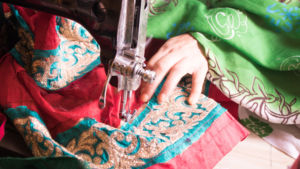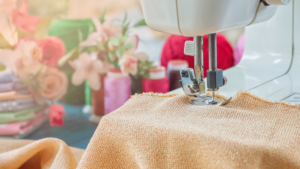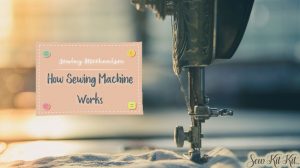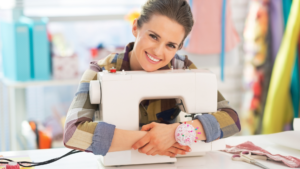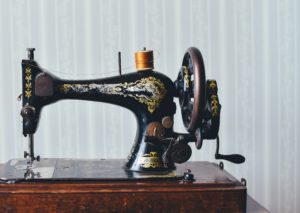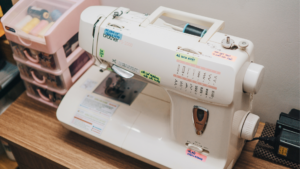Last Updated on June 1, 2022
Are you having trouble determining what size needle you need for your sewing machine? In this guide, we will show you how to figure out exactly what size needle you need.
Could you imagine a sewing machine without a needle? Probably not because a sewing machine needle is a vital part of a sewing machine.
Figuring out the right sewing machine needle sizes might be a bit overwhelming to some because using the wrong needle can damage your sewing machine, the needle itself, and the fabric.
In this guide, we will help you find the right one.
Parts of a Sewing Machine Needle
The sewing machine’s needle eye is positioned at the needle’s point, and the needle is solid at the top. The eye of a hand sewing needle, on the other hand, will be at the very top of the needle. Always remember they are not interchangeable.
It’s necessary to know the parts of a needle to understand how various sewing machine needles differ entirely.
The front side of the house sewing machine needles is round, while the reverse side is flat. When preparing your machine, ensure that the needle is not inserted mistakenly. The shank is the thicker, upper portion of the needle.
The shaft of the needle, which is the circular section with a groove by which the thread will pass before entering through the needle’s eye, which is the open hole, is located below the top of the needle. The needle eventually comes to a point or tip.
A short groove known as a scarf sits above the needle’s eye, allowing the sewing machine’s hook to take up the needle thread and make the stitch.
As we’ll see momentarily, modifying the size or shape of a needle’s eye, shank, scarf, groove, or tip affects the needle’s function.
The basics of choosing a sewing needle
In most situations, you’ll choose your sewing machine needle size and type depending on the characteristics of the fabric and thread. Let’s have a glimpse at it now.
Here is a more detailed guide about choosing the right sewing machine needle.
What do numbers mean when it comes to sewing machine needle sizes?
Needles come in a variety of sizes, with both an American and European size designation. The sizes describe the width of the shaft.
The European numbering and the actual diameter of the needle have an easy-to-remember connection. A 100 needle has a diameter of 1 mm, and a 90 needle has a diameter of 0.9 mm, whereas a 110 needle has a diameter of 1.1 mm.
| European | American | How it is being written |
| 60 | 8 | 60/8 |
| 65 | 9 | 65/9 |
| 70 | 10 | 70/10 |
| 75 | 11 | 75/11 |
| 80 | 12 | 80/12 |
| 90 | 14 | 90/14 |
| 100 | 16 | 100/16 |
| 110 | 18 | 110/18 |
The needle size rule for sewing machines: The lower the needle number, the more sensitive the needle and the more refined the thread it can manage. The thicker the needle and the thicker the thread it can handle, the higher the needle number.
Consider fabric weight when choosing sewing machine needle sizes
In general, select the needle size for your sewing machine, given the weight of the fabric you intend to stitch.
The thickness and structure of the threads used to make the fabric, and the volume of these threads influence the fabric’s weight. A thicker or heavier-weight cloth needs a larger needle to pierce it. A heavy needle will harm a lighter, delicate fabric, necessitating the use of a finer needle. Like, for example, denim. There are two types of denim fabrics: thin, lightweight denim and hefty denim. A larger needle is required for thicker materials.
Rather than a hard and fast rule, think of this as a general suggestion to help you learn.
| Fabric weight | Type of fabrics | Needle size |
| Lightweight | crepe, tulle, chiffon, organza, voile, net, lace, gauze, tricot, silk | 65/9-75/11 |
| Medium-weight | quilting cotton, satin, jersey, seersucker, poplin, rayon, broadcloth, knit, linen, thin denim, elastic, gingham, velvet | 75/11-90/14 |
| Heavy-weight | heavier denim, upholstery, corduroy, vinyl, tweed, canvas, gabardine, oilcloth, velour, wool, leather | 100/16 |
| Extra heavy-weight | Leather, upholstery, extra heavier denim | 110/18 |
Needle Sizes for Sewing Machines: Type of Thread Weight
A larger needle permits a heavier thread. When using a little thread and a large needle, the needle’s tip will create huge holes in the cloth that the fine thread will fill. It might provide the appearance of a tension problem while also being unattractive. When you use a heavy thread with a small needle, you risk missed stitches, broken threads, and what may appear to be a tension issue when the thread has trouble passing through the needle’s eye.
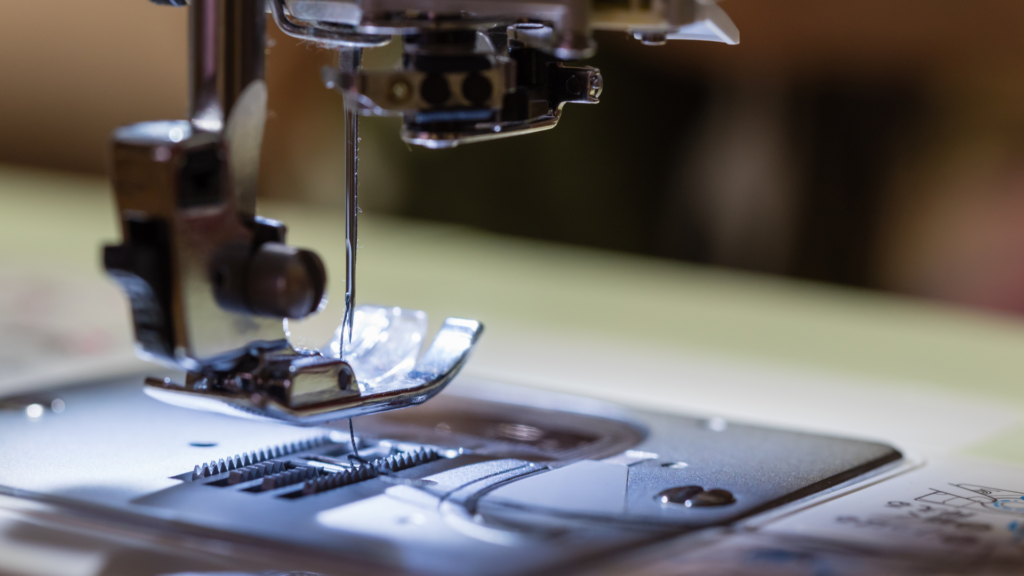
Needle types for sewing machines
General-purpose sewing machine needles are divided into three categories. The ideal for your project in choosing sewing machine needle sizes is determined by woven or knit fabric.
- Universal point needles have a slightly rounded tip and are used for a variety of purposes. They are the familiar”jack of all trades, master of none.” As a result, they’ll work with almost any woven or knit fabric.
- Ballpoint needles, also known as jersey needles, have rounded tips that slide between knit fabric loops rather than penetrating them, resulting in fabric breakage or missed stitches. Pick a good ballpoint needle when you know your fabric is a knit because they are developed mainly for sewing on knits.
- Sharp point needles, also known as Microtex needles, have a sharp tip and are ideal for penetrating dense woven fabrics. They may penetrate the cloth neatly and with minimum resistance due to the sharp tip. This needle is best for tightly woven natural materials, such as silk, or particularly heavyweight wovens. These are particularly excellent for topstitching, which often necessitates sewing through many layers of cloth and interfacing.
Specialty needles
While the three general-purpose sewing needles mentioned above cover many jobs, specialized needles do specific tasks much better. While the suitable needle from the all-purpose needles will suffice for most sewing jobs, it’s essential to be aware of alternative possibilities for solving sewing difficulties.
- Topstitch needles feature a comprehensive eye, a sharp point, and an expanded groove to accept thick, ornamental threads required for many layers of topstitching.
- Stretch needles are a “specialized” variant of a ballpoint needle that does not harm stretch fabrics when used to sew them.
- Denim/jeans needles have a long, sharp tip and perform well on denim and canvas, tightly woven heavyweight materials.
- Metallic needles feature enlarged eyes, which allow metallic and other specialized threads to slide through with less friction, resulting in less thread breakage.
- Machine embroidery needles have a large eye and groove, and the point is medium-sharp. While embroidering, these characteristics prevent delicate threads from unnecessary friction.
- When stitching with leather, use a leather needle, which is fashioned like an arrowhead and has a wedge form. The needle pierces the leather without ripping it, creating skipped stitches, or harming it in any way. If the leather grips the needle and doesn’t let go when the stitch is created, it will skip it. You should not use leather needles on knits or woven textiles!
- Quilting needles feature a unique curve to their sharp point, making them ideal for machine quilting, particularly piercing. Their tapered shape allows them to readily penetrate many layers of cloth and regions with crossing seams.
- Twin needles on a single shaft make two lines of parallel stitches in this pattern. I typically use my twin needle to make a fake cover stitch while sewing hems on clothes. Pintucks, ornate topstitching, and heritage sewing are all done using them.
- Hemstitch needles have a broad blade, often known as a wing, on either side. Each time the needle passes through the cloth, it creates a beautiful groove.
- Needles of various types are universal needles with two eyes for two different threads, known as double eye needles. Quick-threading needles have a slot on the slide where may slip the thread into the eye. I’m sure there are more I’m forgetting, but I’ve gone through my needle collection and haven’t found any new ones yet!
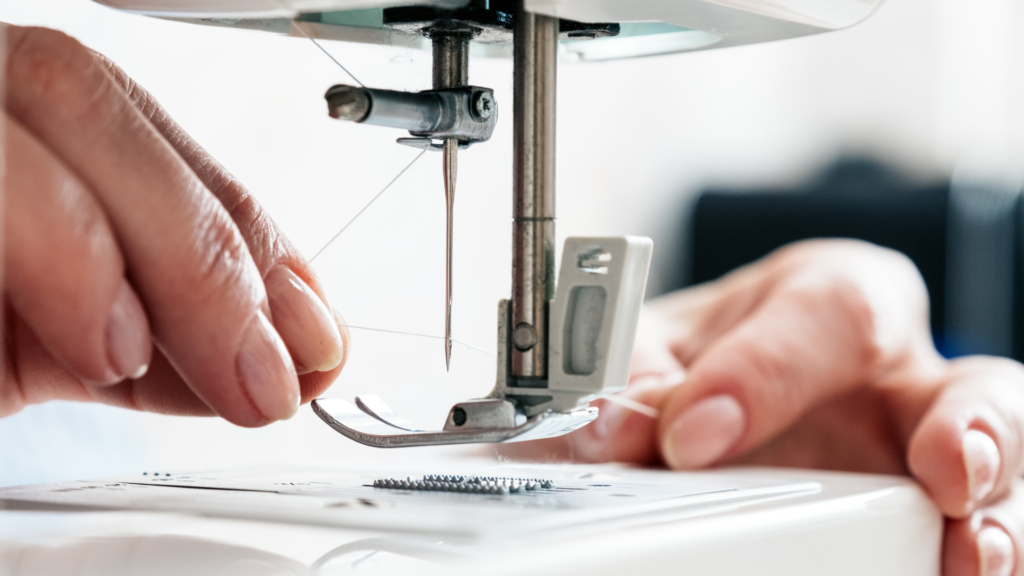
Some Final Words
With all of the possibilities, selecting the correct sewing machine needle size for your project may appear to be a difficult task, but keep in mind that there are many solutions for needles that will work in many situations.
A sewing machine needle may function wonderfully for one job, but it may lead to trouble for another.
For example, knits won’t work with a leather needle, and dense woven textiles won’t work with a ballpoint needle.
Taking the time to choose the right needle for your sewing project is well worth the effort.
Happy Sewing!

